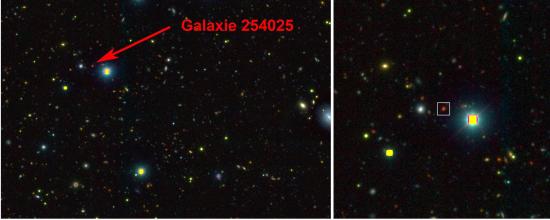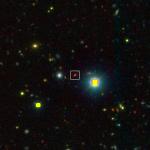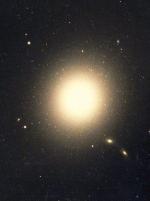An international team of astronomers led by Dr. Masato Onodera at the Astrophysical Department of the Commissariat a l'Energie Atomique in France [1] has used the Subaru Telescope [2] to take an infrared spectra of a very distant, extremely bright, massive elliptical galaxy. This galaxy is 10 billion light-years from Earth and is observed at time when the Universe was only about one-quarter of its current age. Paradoxically, and in contrast with some previous studies, this galaxy appears to be a similar to its cousins in the local Universe. This research deepens the puzzle as to how some elliptical galaxies seem to be "fully grown" early in the evolution of the Universe while other, very compact ones, can increase in volume a hundred times over the age of the Universe. The results are published in the The Astrophysical Journal of 20 Mai 2010
Do the massive elliptical galaxies change sizes ?
The most massive galaxies in the nearby Universe are giant ellipticals. They have a regular, oval shapes and do not have disks like spiral galaxies such as our own Milky Way.
Using large telescopes, astronomers have now identified elliptical galaxies more than ten times more massive than the Milky Way and as far away from Earth as 10 billion light years. Observing the light from such distant elliptical galaxies permits the direct study of how they looked shortly after their formation and opens a window to exploring the Universes' distant past.
Five years ago, extremely deep images from the Hubble Space Telescope suggested that distant elliptical galaxies might be two to five times smaller than nearby ellipticals of the same mass. Such distant giant ellipticals have been found with size less than about 3,000 light years, much smaller even than the Milky Way. If this finding was accurate then this would mean that densities of more distant ellipticals are 10 to 100 times higher than local ones. Since then, scientists have debated how these very compact galaxies could expand over the intervening 10 billion years so that they matched the size of their local counterparts. Many questioned whether the measurements of the size of the distant ellipticals were accurate. Could some measurement error or bias account for their apparently small size?
Weighting the galaxies
Onodera's team turned to the one of the world's largest census of the distant Universe, the COSMOS survey, to find new candidates for the most massive distant giant elliptical galaxies. They looked for objects with a unique "fingerprint" of visible and near-infrared light as measured in Subaru's Suprime-Cam camera and the Canada-France-Hawaii Telescope's WIRCAM camera. Finally, they used the COSMOS team's unique database of high-resolution Hubble space telescope images to pick objects which had similar shapes to local ellipticals of the same mass. This final sample of objects was selected for further observations at the Subaru telescope.

Left : Composite image of a field of distant galaxies obtained from images taken with the Subaru telescope's Suprime-Cam instrument (B and z' images for the blue and green channels, respectively) and WIRCAM on the Canada-France-Hawaii telescope (Ks filter for the red channel). The field size is 6 arc-minutes by 4 arc-minutes. The target galaxy 254025, at a distance of 10 billion light years, is a very faint red point. Right : Zoom at the position of the galaxy, marked by the small square. Masks have been added to the brightest background images. Copyrights Subaru/CFH/SAp
To "weigh" the galaxies, Onodera's team decided to use a different measurement, the "velocity dispersion" of stars to estimate the evolutionary status of a distant elliptical galaxy. Velocity dispersion is a measure of the spread of velocities of stars or galaxies and is a way of determining the object's mass. The smaller the size of a galaxy of a given mass, the faster the stars have to move in order to balance the pull of gravity. Measurements of the broadening of spectral lines in the galaxy's spectrum can indicate the speed of the stars and allow deriving the mass of the galaxy combining size and velocity.
However, strong spectral lines appropriate for making these measurements of distant galaxies exist in the near infrared range of the spectrum, beyond visible light, where observations are particularly difficult. Equipped with its Multi-Object Infrared Camera and Spectrograph (MOIRCS), the Subaru Telescope was particularly well-suited for revealing these spectral lines, because it can capture infrared light from multiple objects in a wide field of view, providing images and spectroscopic measurements of their composition.
This is a relatively new way to measure the mass of distant galaxies. The first measurement of this kind was published only recently and yielded a large velocity dispersion (around 500 km per second) that reveals a typical size of only 2 500 light years with a most probable mass of 200 billion solar masses : extreme proportions that have no counterpart among local galaxies. Using the same technique, the galaxy, ID 254025, found by Onodera's team has a smaller velocity dispersion (around 300 km per second) which is more consistent with its large size of about 19 000 light years. With a mass of 700 billion solar masses, this galaxy has therefore proportions similar to the local galaxies. These results provide evidence that large, fully-grown galaxies coexist with very compact ones in the early Universe.
The mystery of how different elliptical galaxies form and develop is still unsolved. Onodera's team is now turning to the problem of determining the relative proportion of these two extreme types of elliptical galaxies as a function of cosmic time. Further observations with Subaru Telescope's MOIRCS lie ahead to help solve this puzzle.
Contacts : (CEA) and (CEA)
Publications :
« A z=1.82 Analog of Local Ultra-massive Elliptical Galaxies»
M. Onodera, E. Daddi, R. Gobat, M. Cappellari, N. Arimoto, A. Renzini, Y. Yamada, H. J. McCracken, C. Mancini, P. Capak, M. Carollo, A. Cimatti, M. Giavalisco, O. Ilbert, X. Kong, S. Lilly, K. Motohara, K. Ohta, D. B. Sanders, N. Scoville, N. Tamura, Y. Taniguchi
published in the "Astrophysical Journal Letters" of 20 Mai 2010, vol.715, L6
for an electronic version  ficher PDF
ficher PDF
See : the CNRS-CEA press release (20 May 2010, in French)
the Subaru Press Release (20 May 2010)
See also : - Molecular Gas Seen inside Ordinary Galaxies in the Young Universe (23 Janvier 2008)
- Formation d'étoiles dans l'Univers lointain (7 Juin 2007, in french)
Notes :
[1] ANR. The project was funded partially by the Agence Nationale de la Recherche (allocations ANR-07-BLAN-0228 and ANR ANR-08-JCJC-0008) and the Commission Européenne de la Recherche (allocation UPGAL-240039)
[2] The Subaru telescope with a 8,2 m diametre mirror, is in operation since 1998 at the summit of Mauna Kea in Hawaii (USA). It was built by the Japan National Observatory and got its name from the Pleiades constellation, "subaru" in Japanese).
• › Galaxy formation and evolution Structure and evolution of the Universe
• Institute of Research into the Fundamental Laws of the Universe • The Astrophysics Division (DAp)





